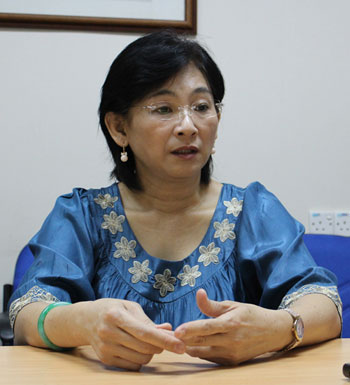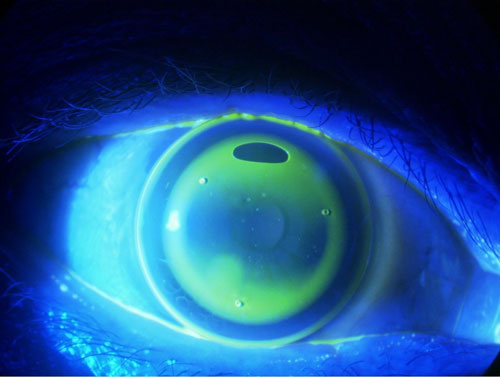
EYE EXPERT: Prof Dr Cho now teaches Contact Lens Practice at the Hong Kong Polytechnic University School of Optometry and also conducts major researches on coloured contact lenses and orthokeratology.

RISKS: Coloured contact lenses may prove harmful if not prescribed by a qualified optometrist. — Photo courtesy of Dr Pauline Cho

WATCH OUT: Novelty contact lenses which are popular, especially during occasions like Halloween, can cause damage to the eyes or even blindness when not properly used and cleaned. — AFP photo
SINCE its introduction, the contact lens has evolved considerably over the last 40 years into various material types to suit a wider range of prescriptions.
These days, contact lenses, especially novelty lenses, which come in a variety of colours, shapes and patterns, are worn more frequently due to fashion consciousness.
However, Professor Dr Pauline Cho from Hong Kong Polytechnic University School of Optometry cautioned that wearing coloured contact lenses not prescribed by qualified optometrists or eye-care professionals may harm the eyes.
“Nowadays, a lot of people can easily purchase contact lenses, especially coloured or decorative ones, on the Internet.
“This is wrong because we do not know where the lenses come from, how they were made and what colouring has been used to tint the lens,” she told thesundaypost.
Sibu-born Prof Dr Cho has since 1988 been based in Hong Kong where she now teaches Contact Lens Practice at the University and also conducts major researches on coloured contact lenses (orthokeratology), compliance in contact lens wear and care; microbial contamination of contact lenses and lens accessories as well as tears and dry eye, among others.
“These days, you can conveniently find coloured contact lenses such as at beauty product centres, flea markets and on the Internet.
“First of all, contact lenses are not consumables and should not be used as a commodity. They are actually considered medical devices and every purchase should come with service such as proper eye examination from the optometrists,” she explained.
According to her, there have been a number of reports where consumers who wore coloured contact lenses caught an infection because they forgot to take their lenses off before sleeping or they did not know the proper way of handling the lenses.
“When these infections are not treated immediately, they can cause corneal ulcers or worst, blindness,” Prof Dr Cho cautioned.
In view of this, she advised those who like wearing contact lenses – whether to improve vision or for cosmetic purposes — to have them prescribed by qualified optometrists who will custom-fit the lenses to their eyes.
“They will also advise on how to wear the contact lenses, and regardless of how your put them on, regular eye checks should be practised.”
Prof Dr Cho pointed out that regular eye examinations were important as eye problems occurred progressively.
“Eye problems don’t give you an immediate effect — so if you don’t have your eyes checked regularly, by the time your eyes are all red and painful, it’s probably too late,” she said, stressing that contact-lens wearers should have their eyes checked once every six months to a year.
On whether action can be taken against unlicensed sellers of novelty contact lenses, Prof Dr Cho said presently, contact lenses were not registered as medical devices.
“The Malaysian Optical Council (MOC) under the Health Ministry requires all practising optometrists to register with it and sellers of unauthorised contact lenses can be prosecuted.
“However, it’s online sales of contact lenses that prove to be a problem because there are so many on the Internet,” she said, adding that improving the situation falls within the consumer’s responsibility.
“It’s up to consumers to control the sales of unauthorised lenses – whether they want to take the risk or not.”
Another cause for concern in eye problems is the rising number of children with myopia, more commonly known as short-sightedness.
“More children are becoming short-sighted and prevalence of myopia that used to occur among children aged seven or eight, can now be found in children as young as three,” expla ined Prof Dr Cho who has been working on myopia control research for more than a decade.
She said there were various factors that contributed to this such as lack of sun exposure and genetics but the number one reason for the staggering rate of myopic children is associated with “near work.”
“Children nowadays spend most of their time in “near work” – be it doing their homework, reading or playing games with their smartphones or tablets — which is probably going to get worse from hereon.
“As such, my team and I are now also conducting research on orthokeratology which is a special type of contact lenses to control or slow down progression of myopia in children.”
Presently, the research has been carried out on children between ages six and 12 as this is when occurrence of myopia in children is fastest.
Although Prof Dr Cho acknowledged reducing the rate of myopia may be easier said than done as parental commitment is required, she encouraged children to participate in more outdoor activities.
“In Hong Kong, it’s getting very difficult for children to have outdoor activities as our outdoor activities are limited but in Sarawak, there is plenty to see or do outside.
“Apart from that, parents should keep a watchful eye on their children and not let them play with their tablets for too long, read in dim lighting and so on. In other words, moderation is key.”
Prof Dr Cho was recently in Kuching to speak at a seminar on eye care, organised by the Sarawak Optical Traders Association and the Malaysian Academy of Optometry.
Before this, she had given talks in countries such as Hong Kong, Singapore, England, Holland, Italy, Japan, China, Australia and Korea.
Apart from academic and research achievements, Prof Dr Cho is also involved in various community and voluntary services and organises annual vision screening for ethnic minority children and visits to leprosy villages in Guangxi, China.
